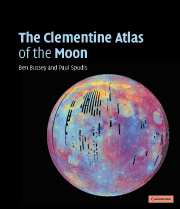Book contents
- Frontmatter
- Dedication
- Contents
- Preface to original edition
- Preface to revised edition
- Part I The Moon
- Introducing the Moon – its motions, properties and history
- A short history of early lunar exploration
- Recent lunar exploration: from Clementine to today
- A new golden age of lunar exploration
- Atlas details
- Part II The Clementine lunar atlas
- Plate section
Atlas details
Published online by Cambridge University Press: 05 September 2013
- Frontmatter
- Dedication
- Contents
- Preface to original edition
- Preface to revised edition
- Part I The Moon
- Introducing the Moon – its motions, properties and history
- A short history of early lunar exploration
- Recent lunar exploration: from Clementine to today
- A new golden age of lunar exploration
- Atlas details
- Part II The Clementine lunar atlas
- Plate section
Summary
The Clementine data
The Clementine spacecraft entered a 400–3000 km elliptical lunar orbit on 19 February 1994. It remained in this 5 h period orbit for 71 days, systematically mapping the surface of the Moon with its instrument suite (Table 4). Because of the elliptical nature of the orbit, perilune (the point of closest approach the lunar surface) was moved from 28° S to 30° N approximately half-way through the mapping phase of the mission (Figure 20). This ensured that the entire surface of the Moon was mapped at approximately the same resolution.
The imaging data set shown in this atlas comes from Clementine's ultraviolet-visual (UV–VIS) instrument. The UV-VIS camera was essentially a digital camera with a 384 × 288 pixel array. This camera contained five filters and imaged over 99% of the lunar surface at an average resolution of 200 m/pixel. The images used here were taken with the 750 nm filter as they are close to the visible part of the spectrum and are of better quality than the 415 nm images.
Because of the redundant overlap in surface coverage at high latitudes between consecutive orbits, the Clementine team devised a mapping strategy that conserved data volume. In a type A orbit the spacecraft (travelling from south to north) began mapping at 70° S and finished imaging when it was above the North Pole. In a type B orbit, mapping began at 90° S and finished at 70° N. Type A and B orbits were alternated on each revolution, resulting in a seamless, global digital image of the Moon (Figure 20).
- Type
- Chapter
- Information
- The Clementine Atlas of the Moon , pp. liv - lxPublisher: Cambridge University PressPrint publication year: 2004



